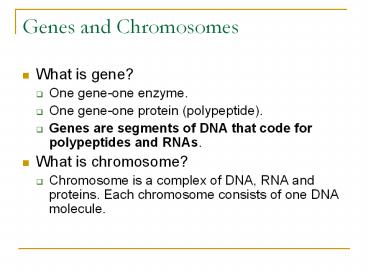Genes and Chromosomes PowerPoint PPT Presentation
1 / 45
Title: Genes and Chromosomes
1
Genes and Chromosomes
- What is gene?
- One gene-one enzyme.
- One gene-one protein (polypeptide).
- Genes are segments of DNA that code for
polypeptides and RNAs. - What is chromosome?
- Chromosome is a complex of DNA, RNA and proteins.
Each chromosome consists of one DNA molecule.
2
How does genes function? Central Dogma DNA to
RNA to Protein.
3
The Size and Sequence of DNA Molecules in
Bacteria and their viruses
Bacteria(E. coli) 4,639,221 1.7 mm
0.002 mm
4
T2 phage
5
The sizes of E. coli cell and its DNA
6
DNA from a lysed E. coli cell
7
8
DNA content and C-value paradox
9
Eukaryotic genomes have several sequence
components
- Nonrepetitive DNA the complexity of the slow
component corresponds with its physical size,
i.e., unique sequences. - Moderately repetitive DNA.component with a
Cot1/2 of 10-2 and that of nonrepetitive DNA.
Contains families of sequences that are not
exactly the same, but are related. The complexity
is made up of a variety of individual sequences,
each much shorter, whose total length together
comes to the putative complexity (eg.,6 x 105 bp
in the Fig. shown above). Usually dispersed
throughout the genome. - Highly repetitive DNA component which
reassociates before a Cot1/2 of 10-2. Usually
forms discrete clusters.
10
Types of sequences in the human genome
11
Eukaryotic Chromosomes
12
Centromere Mitotic segregation of chromosomes.
Simple-sequence DNA is located at centromere in
higher eukaryotes. Telomere At ends of
chromosomes. (TTAGGG)n in human.
13
Many eukaryotic genes contain intervening
sequences (introns)
14
How is DNA packed in the chromosomes
- DNA Supercoiling.
- Proteins assisted packaging (nucleosomes)
15
Supercoils
16
Supercoiling of DNA can only occur in
closed-circular DNA or linear DNA where the ends
are fixed.
Underwinding produces negative supercoils, wheres
overwinding produces positive supercoils.
17
Negative and positive supercoils .
Topoisomerases catalyze changes in the linking
number of DNA.
18
Supercoiling induced by separating the strands of
duplex DNA (eg., during DNA replication)
19
Relaxed and supercoiled plasmid DNAs
20
Negative supercoils facilitate separation of DNA
strands (may facilitate transcription)
21
Topology of cccDNA is defined by Lk Tw Wr,
where Lk is the linking number, Tw is twist and
Wr is writhe.
22
Intertwining of the two strands
- Nodes ss crossing on 2D projection.
Right-handed crossing 1/2
Left-handed crossing -1/2
Lk number of times one strand winds around the
other on 2D projection. One linking number 2
nodes.
23
(No Transcript)
24
(No Transcript)
25
Promotion of cruciform structures by DNA
underwinding
26
(No Transcript)
27
Mechanism of Type I topoisomerase action
28
(No Transcript)
29
(No Transcript)
30
Proposed mechanism of Type II topoisomerase action
31
Plectonemic supercoiling
32
DNA Compaction Requires Solenoidal Supercoiling,
not plectonemic supercoiling.
33
Changes in chromosome structure during the cell
cycle
34
Protein-assisted Packaging of DNA Nucleosomes are
the fundamental organizational units of
eukaryotic chromatin
35
Each nucleosome has a histone core wrapped by DNA
(146 bps) in a left-handed solenoidal supercoil
about 1.8 times. The linker DNA is about 54 bps
in length.
36
DNA wrapped around a nucleosome core
37
Histones are small, basic protein. The histone
core in nucleosomes contains two copies each of
H2A, H2B, H3 and H4. Histone H1 binds to linker
DNA.
38
Chromatin assembly
39
Nucleosomes are packed into successively
higher-order structures
The 30 nm fiber, a higher-order organization of
nucleosomes.
40
A partially unraveled human chromosome, revealing
numerous loops of DNA attached to scaffold.
41
Higher order of folding is not yet understood.
Certain regions of DNA are associated with a
nuclear scaffold. The scaffold associated regions
are separated by loops of DNA with 20 to 100 kb
long.
42
Model of DNA compaction in eukaryotic chromosomes
43
Condensed chromosome are maintained by SMC
proteins
SMC Proteins
44
(No Transcript)
45
Model for the effect of condensins on DNA
supercoiling

